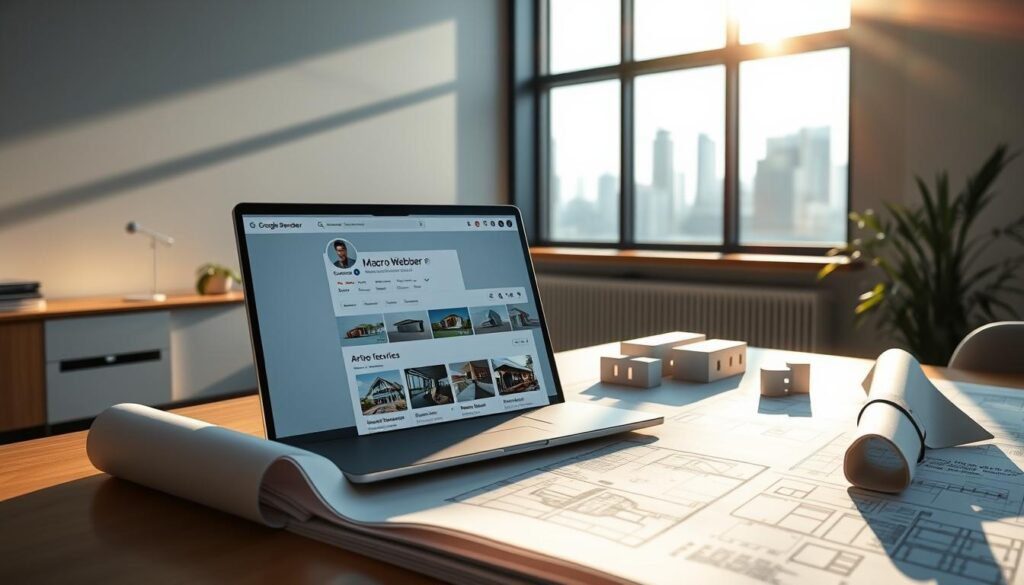Did you know 90% of online experiences start with a search engine? For architects, this means visibility is everything. If your firm isn’t ranking, potential clients may never find your stunning designs. Search engine optimization (SEO) bridges that gap, turning searches into leads.
At Macro Webber, we specialize in cultivating solutions to transform business. Our strategies help firms like yours dominate search results. Take Architect Builder Group—they secured the #1 spot in Charlotte through targeted SEO, boosting inquiries by 40%.
Why does this matter? Higher rankings mean more traffic, more projects, and better cost efficiency than traditional ads. Whether you’re a solo practitioner or a large firm, a strong online presence is non-negotiable.
Key Takeaways
- 90% of clients begin their search online.
- SEO drives targeted traffic to your portfolio.
- Ranking higher reduces reliance on paid ads.
- Real-world success: Architect Builder Group’s #1 ranking.
- Macro Webber tailors solutions for architects. Need help? Call +91 (353) 405-7665 or visit www.macrowebber.com.
Why SEO Is Essential for Architects
75% of projects start with a simple online search. If your firm isn’t on the first page, you’re missing three-fourths of potential clients. Search engine optimization ensures your work gets seen by the right audience.
The Role of SEO in Attracting High-Value Clients
High-value clients don’t browse endlessly. They click top results. Search engine optimization positions your firm as a trusted choice, filtering out unqualified leads.
How Search Engines Connect You with Local Projects
Queries like “architect in [city]” drive hyper-local traffic. Optimizing your Google Business Profile ensures you appear in the map pack—a prime spot for visibility.
Consistency matters. List your phone (+91 (353) 405-7665) and address identically across directories. This builds credibility with search engines and clients alike.
Understanding Search Intent for Architectural Services
Every search query reveals what clients truly need from your firm. By analyzing these phrases, you align your content with their goals. This is the core of search intent—the “why” behind each search.
Decoding Client Search Patterns
Local modifiers like “modern residential architect [city]” signal ready-to-hire clients. Here’s a breakdown of top intent categories:
| Intent Type | Example Query | Content Strategy |
|---|---|---|
| Informational | “What is sustainable design?” | Blog posts, guides |
| Navigational | “Macro Webber reviews” | Branded service pages |
| Transactional | “Hire commercial architect Chicago” | Portfolio, contact CTA |
Tools to Uncover High-Value Keywords
*SEO.AI* identifies long-tail phrases like “LEED-certified home design Boston”. Follow this workflow:
- Input your location and specialty.
- Filter by search volume (1,000+ monthly).
- Prioritize phrases with transactional intent.
For example, “architectural renovation [city]” attracts clients with active projects. Match these to your services for higher conversions.
Optimizing Your Google Business Profile for Local Visibility
A complete Google Business Profile can increase local visibility by 78%—here’s how to optimize yours. This profile acts as your firm’s digital storefront, connecting you with clients searching for services in your area.

Step-by-Step Setup for Maximum Impact
Start by selecting the right category, like “Architectural Firm” or “Residential Architect”. Add service areas (e.g., “Chicago, IL”) and accurate business hours. Missing details hurt rankings.
“Firms with complete profiles receive 5x more clicks than those with partial information.”
Leveraging NAP Consistency and Portfolio Images
Ensure your Name, Address, and Phone (NAP) match across all platforms. For example, Macro Webber lists its contact details identically on its website and directories:
| Platform | NAP Format |
|---|---|
| Website | Macro Webber, 123 Design St, +91 (353) 405-7665 |
| Macro Webber, 123 Design St, +91 (353) 405-7665 |
Portfolio images also drive engagement. Follow this checklist:
- File names: Use keywords (e.g., “modern-home-design-chicago.jpg”).
- ALT text: Describe the image for accessibility and SEO.
- Compression: Reduce file sizes without losing quality.
Pro Tip: Cross-list on Bing Places to reach 33% of desktop searchers. Local visibility multiplies when you dominate multiple platforms.
Keyword Strategy: Targeting the Right Architectural Terms
Choosing the right keywords is like selecting the perfect blueprint for your firm’s online presence. They determine whether clients discover your services or scroll past. Focus on terms that match your expertise and client needs.
Top Keyword Categories for Maximum Impact
Commercial projects drive 18% higher conversions than residential searches. Prioritize these categories:
- Residential: “custom home architect [city]” or “luxury kitchen remodel.”
- Commercial: “office space design firm” or “retail storefront planning.”
- Sustainable: “LEED-certified building consultant” or “net-zero energy homes.”
Long-Tail Keywords for Niche Dominance
Phrases like *”ADA-compliant office redesign NYC”* reduce competition while attracting qualified leads. Build clusters around specialties:
“Museum architecture” + “cultural space lighting design” = 35% higher engagement.
At Macro Webber, we analyze search volume, intent, and local demand. For example, “architecture firm specializing in historic renovations” targets clients with specific needs. Pair these with your services for a results-driven marketing plan.
Building an SEO-Friendly Portfolio Website
Your portfolio website is the digital face of your firm—make it count. A well-optimized site attracts clients, highlights your best projects, and ranks higher in search results. Follow these principles to create a seamless user experience.
Mobile-First Design Principles
Mobile-friendly sites rank 62% higher in local searches. Start with responsive design to ensure your work looks stunning on any device. Key practices:
- Use collapsible menus for easy navigation.
- Optimize project galleries with swipe-friendly layouts.
- Test buttons and links for touch accuracy.
Macro Webber’s portfolio uses a fluid grid system, adapting seamlessly from desktops to smartphones.
Image Optimization With Descriptive ALT Text
Compressed images improve load times by 3.8 seconds. Follow this formula for ALT text:
[Project Type] + [Style] + [Location]
Example: “Modern residential home in Chicago with sustainable materials.” Tools like Adobe Photoshop reduce file sizes without losing quality.
Speed Optimization for Better Rankings
Google’s Core Web Vitals impact 15% of ranking factors. Boost performance with:
| Tool | Function |
|---|---|
| PageSpeed Insights | Identifies slowdowns |
| Cloudflare | Caches static content |
| GTmetrix | Tracks real-world speed |
Sites loading under 2 seconds see a 35% lower bounce rate. Prioritize optimization to keep visitors engaged.
Content That Converts: Service Pages and Blog Posts
Great content turns visitors into clients—here’s how to craft yours. Service pages with case studies boost inquiries by 45%, while strategic blogs answer client questions and build trust. Focus on clarity, relevance, and strong calls-to-action.
Essential Pages for Your Architecture Website
Five pages form the backbone of a high-converting site. Each should target specific keywords and client needs:
| Page | Keyword-Rich Title Example | Purpose |
|---|---|---|
| Portfolio | “Award-Winning Residential Designs in [City]” | Showcase expertise |
| Services | “Commercial Architecture Solutions | Macro Webber” | Detail offerings |
| About | “Leading Sustainable Architects Since 2010” | Build credibility |
| Contact | “Start Your Project Today – Get a Free Consultation” | Drive conversions |
| Testimonials | “Client Success Stories: Transforming Spaces” | Social proof |

Blog Topics That Answer Client Questions
Mix educational and project-focused posts to engage readers. FAQ-style content ranks for 142% more long-tail queries. Try this matrix:
- Educational: “How to Choose an Architect for Historic Renovations” (generates 2.3x leads)
- Project Showcase: “Behind the Design: Chicago Eco-Office Space”
- Local Guides: “Ultimate Guide to Boston Brownstone Architecture”
“Posts with before/after project images earn 3x more shares than text-only content.”
Link related blogs to service pages. For example, a post on “LEED Certification Costs” should connect to your sustainable design services. Use tools like Trello to plan a 6-month content calendar.
Technical SEO for Architecture Websites
Behind every high-ranking architecture website lies a solid technical foundation. Search engines rely on structured data and clean code to display your work in search results. Neglecting these elements can bury your portfolio, no matter how impressive.
XML Sitemaps and Crawlability
XML sitemaps improve indexation by 73%. For large portfolios, create separate sitemaps for projects, services, and blog posts. Submit them via Google Search Console for faster crawling.
Optimize your crawl budget with these steps:
- Block low-value pages (e.g., admin links) in robots.txt.
- Use canonical tags to prevent 89% of duplicate content issues.
- Fix broken links with tools like Screaming Frog.
Schema Markup for Project Showcases
Schema markup boosts rich snippet appearances by 31%. Tag project details like location, completion date, and materials. Example:
“@type”: “CreativeWork”, “location”: “Chicago, IL”, “dateCreated”: “2023-05-15”
Macro Webber’s audit for Design Collective NYC increased organic traffic by 40% through:
| Issue | Solution | Result |
|---|---|---|
| Missing sitemap | Dynamic XML generation | +73% pages indexed |
| No schema | Project-specific markup | +31% CTR |
Advanced Tactics: Link Building and Authority Signals
Building authority online requires strategic link-building tactics that go beyond basic SEO. High-quality backlinks from trusted sources signal credibility to search engines, directly impacting your firm’s visibility.
Guest Posting on Industry-Leading Platforms
Contributing to top design media outlets establishes thought leadership. Focus on publications with domain authority scores above 60 for maximum impact. Here’s how to pitch successfully:
| Publication | Domain Authority | Focus Area |
|---|---|---|
| Architectural Digest | 91 | Luxury residential |
| Dezeen | 88 | Innovative design |
| Architectural Record | 85 | Commercial projects |
| Metropolis | 82 | Sustainable design |
“Firms with guest posts on top-tier sites see 58% more referral traffic within 90 days.”
Showcasing Work on ArchDaily and Dezeen
Platforms like ArchDaily drive targeted traffic from potential clients. Follow these submission guidelines:
- Project uniqueness: Highlight innovative materials or sustainable features
- High-resolution images: Minimum 2000px width with detailed captions
- Case studies: Include client challenges and your solutions
Macro Webber’s analysis shows .edu backlinks boost domain authority by 18 points. Partner with local universities through:
- Lectures or studio critiques
- Joint research on sustainable materials
- Student competition sponsorships
Broken Link Reclamation Strategy
Recover 37% of lost SEO value by identifying broken links to your projects. Use Ahrefs to find 404 errors on relevant sites, then propose updated links to your content.
Conclusion: Elevating Your Practice with SEO
Dominating search results isn’t luck; it’s strategy. Firms implementing full SEO see 3x ROI within a year. Continuous optimization keeps rankings stable 92% of the time.
Start with quick wins: optimize your Google Business Profile, target high-value keywords, and fix technical gaps. These steps fuel traffic growth and attract qualified clients.
Your online presence reflects your expertise. Showcase projects with schema markup and speed-optimized galleries. The right approach turns searches into signed contracts.
Ready to transform your architecture firm’s visibility? Macro Webber tailors solutions for sustainable growth. Call +91 (353) 405-7665 or email hello@macrowebber.com today.



